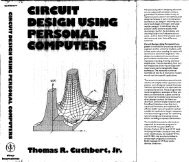IEEE New Jersey Coast Section Centennial Journal Part - GHN
IEEE New Jersey Coast Section Centennial Journal Part - GHN
IEEE New Jersey Coast Section Centennial Journal Part - GHN
Create successful ePaper yourself
Turn your PDF publications into a flip-book with our unique Google optimized e-Paper software.
ilgement and a firm, exPerienced<br />
d. Watters handled literally every<br />
qpc of problem imaginable every day<br />
ad he did it with great insight and good<br />
hor. His many talents were fullY<br />
rcd in this challenging assignment,<br />
dirh some of us likened to being a<br />
drplain in an insane asylum. lt must<br />
tqebv be realized that the chapter of<br />
activities, singled out for special<br />
IEE<br />
&cussion in this article, represented<br />
h a small fraction of the overall<br />
msion effort conducted bY the 3500<br />
gusonnel at the laboratory complex.<br />
-{s vre entered 1959, ou r sPace<br />
mtributions continued.<br />
After four failures since April t958<br />
m place a fu\\ siz-e rnstrumented pay\oad<br />
mto orbit. the last of them containing<br />
fu SRDL conceived and develoPed<br />
-cloud-cover" instrumentatlon,<br />
l'anguard was readY on 17 FebruarY<br />
UINTER 1982<br />
1959 to make another try' It was<br />
successful and the Vanguard program<br />
had finally delivered the first ofthe long<br />
overdue originallY Planned IGY<br />
satellites. lt was designated Vanguard 2<br />
and carried the backuP model of our<br />
cloud-cover instrumentation.<br />
But while successful PhYsical<br />
orbiting of the 22-pound payload was<br />
demonstrated, a mishap during the final<br />
orbit insertion made the PaYload<br />
virtually useless. The satellite had<br />
already been separated from the burnt<br />
out last stage rocket and was perfectly<br />
on its way when residual fuel in the<br />
rocket reignited and ProPelled it<br />
forward, kicking the satellite in the back<br />
and sending it tumbling erraticalll'. The<br />
cloud-cover imaging concept was based<br />
on scanning the earth in circular sweeps<br />
with photoelectric sensors as the<br />
rotating satellite moved along its orbit.<br />
Therefore, the now irregular tumbling<br />
motion made image comPutation<br />
impractical. Ironically, the payload's<br />
eleclronics performed perfectly for the<br />
l8 lays of battery life. but in spite of<br />
desperate attempts to derive images<br />
from the data, through simulation and<br />
computer programs, the effort had to be<br />
given up finally.<br />
But a much more soPhisticated<br />
clourl-cover and meteorological<br />
satellite was already coming along:<br />
TIROS (Television and lnfrared<br />
Observation Satellite). This sateilite<br />
included two television cameras. one<br />
with a wide angle and one with a narrow<br />
angle view. The picture taking periods<br />
of these cameras could be<br />
preprogrammed from ground stations<br />
for each orbit to coincide with proper<br />
ln 1960 TIROS I (far left)tookthese<br />
two photograPhs among manY<br />
others, from several hundred miles<br />
east of the Atlantic coast from an<br />
altitude of about 450 statute miles'<br />
The photos were sent bY tele vision<br />
to Ft. Monmouth and then<br />
transmitted to NASA, which<br />
conducted the TIROS Project.<br />
ln addition to the TV feature, the<br />
system included infrared sensors for<br />
various wavelengths to obtain overall<br />
heat balance measurements and coarse<br />
lR images using a scanning concept<br />
similar to our cloud-cover<br />
inst rumentatio n.<br />
Actually the TIROS did not<br />
originate at SRDL, nor was it an SRDL<br />
design - although we were involved in<br />
many planning phases and in the final<br />
design stages, esPeciallY in the lR<br />
subsystems.<br />
The project had come a long waY<br />
from ABMA. where it was derived from<br />
Gen. Medaris' ambitious "Eye in the<br />
Sky" surveillance satellite concept and<br />
had resulted in a contract with the<br />
RCA, Princeton. ln July 1958, ARPA<br />
placed the technical direction of the<br />
development and production of the<br />
TIROS payload by RCA into the<br />
responsibility of SRDL.<br />
ARPA's sponsorshiP was later<br />
transferred to NASA and when TIROS<br />
I was successfully launched on I April<br />
1960, it was under the ausPices of<br />
NASA. All systems operaterl perfectly<br />
and flooded the metcorological<br />
community with a total of 22.952 cloudcover<br />
plctures.<br />
'fhe fina\ manaBement oi the<br />
TIROS project represented a rather<br />
complex picture. The Air Force<br />
Ballistic Missile Division was in charge<br />
of the launching vehicle and the<br />
65

















